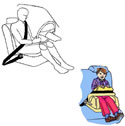 Motor vehicle seatbelt use provides highly effective protection in frontal collisions for impact angles up to 30 degrees off-center (i.e. between 11 and 1 o'clock). All states have laws requiring their use for front seat passengers, as they have been shown to reduce moderate to severe injuries by 50%. They are less effective when your car is hit in the rear or side and sometimes their locking devices malfunction or the anchorage gives way. For children, seatbelts should always be used in conjunction with rear facing infant seats (for infants up to 22 lbs), child seats (for ages 1 to 4, weighing up to 40 lbs) and booster seats for children between 4 and 8 (up to 80 lbs). Back seat placement is required for children in cars equipped with airbags.
Motor vehicle seatbelt use provides highly effective protection in frontal collisions for impact angles up to 30 degrees off-center (i.e. between 11 and 1 o'clock). All states have laws requiring their use for front seat passengers, as they have been shown to reduce moderate to severe injuries by 50%. They are less effective when your car is hit in the rear or side and sometimes their locking devices malfunction or the anchorage gives way. For children, seatbelts should always be used in conjunction with rear facing infant seats (for infants up to 22 lbs), child seats (for ages 1 to 4, weighing up to 40 lbs) and booster seats for children between 4 and 8 (up to 80 lbs). Back seat placement is required for children in cars equipped with airbags.
Expertise
We have extensive experience with many seatbelt issues including:
- Seatbelt stretch and slack effects
- Whether wearing a belt would have reduced injury in a particular accident
- Seatbelt examination and surrogate testing
- Simulating occupants in a crash or rollover with and without a seatbelt
Questions Answered
Through scientific analysis, we can help you answer pertinent questions such as:
- Could the vehicle occupant's head strike the windshield even when wearing a seatbelt?
- Were the victim's injuries consistent with the wearing of a seatbelt?
- Would the injuries sustained have been avoided if a seatbelt was worn?
Case Examples
Rear seated belted passenger fatality:
A woman fell asleep at the wheel and drove her car off the road killing one rear seated young son and seriously injuring a second. By examining the seatbelt ribbon, we detected long abrasion marks that indicated that the seatbelt worn by the deceased malfunctioned. The parent's attorney was able to settle the case easily after disclosing our report to the automobile manufacturer.
Pickup truck rollover:
A pickup truck's brakes failed to hold, causing the driver to swerve to avoid striking cars stopped ahead of him. Two unbelted passengers in the front seat were thrown from the pickup as it rolled, causing a woman to receive a life-long brain injury. We helped the defendant show that the injuries occurred only after the woman left the vehicle, prompting a greatly reduced settlement.
Kristopher J. Seluga, PE, is a Mechanical Engineering, Accident Reconstruction, Biomechanics, and Safety Expert with over 20 years of experience. He received his Bachelor's and Master's degrees from the Mechanical Engineering department at MIT where he worked on the development of novel three-dimensional printing technologies. Mr. Seluga is also a licensed Professional Engineer in New York and Connecticut, and has served as a member of the ANSI engineering committee for the Z130.1 and Z135 standards for golf cars and PTV's. His research interests and peer reviewed publications span the topics of Motor Vehicle Dynamics, Product Safety, and Biomechanics.
©Copyright - All Rights Reserved
DO NOT REPRODUCE WITHOUT WRITTEN PERMISSION BY AUTHOR.



 Motor vehicle seatbelt use provides highly effective protection in frontal collisions for impact angles up to 30 degrees off-center (i.e. between 11 and 1 o'clock). All states have laws requiring their use for front seat passengers, as they have been shown to reduce moderate to severe injuries by 50%. They are less effective when your car is hit in the rear or side and sometimes their locking devices malfunction or the anchorage gives way. For children, seatbelts should always be used in conjunction with rear facing infant seats (for infants up to 22 lbs), child seats (for ages 1 to 4, weighing up to 40 lbs) and booster seats for children between 4 and 8 (up to 80 lbs). Back seat placement is required for children in cars equipped with airbags.
Motor vehicle seatbelt use provides highly effective protection in frontal collisions for impact angles up to 30 degrees off-center (i.e. between 11 and 1 o'clock). All states have laws requiring their use for front seat passengers, as they have been shown to reduce moderate to severe injuries by 50%. They are less effective when your car is hit in the rear or side and sometimes their locking devices malfunction or the anchorage gives way. For children, seatbelts should always be used in conjunction with rear facing infant seats (for infants up to 22 lbs), child seats (for ages 1 to 4, weighing up to 40 lbs) and booster seats for children between 4 and 8 (up to 80 lbs). Back seat placement is required for children in cars equipped with airbags.







